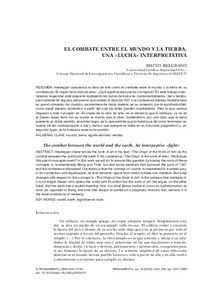Please use this identifier to cite or link to this item:
https://repositorio.uca.edu.ar/handle/123456789/12402| Título: | El combate entre el mundo y la tierra : una «lucha» interpretativa The combat between the world and the earth : an interpretive «fight» |
Autor: | Belgrano, Mateo | Palabras clave: | MUNDO; VERDAD; INTERPRETACION FILOSOFICA; Heidegger, Martin, 1889-1976; OBRAS DE ARTE | Fecha de publicación: | 2020 | Editorial: | Universidad Pontificia de Comillas | Cita: | Belgrano, M. El combate entre el mundo y la tierra : una «lucha» interpretativa [en línea]. Pensamiento. Revista De Investigación e Información Filosófica. 2020, 76 (292). doi: 10.14422/pen.v76.i292.y2020.010. Disponible en: https://repositorio.uca.edu.ar/handle/123456789/12402 | Resumen: | Resumen: Heidegger caracteriza la obra de arte como el combate entre el mundo y la tierra en su
conferencia «El origen de la obra de arte». ¿Qué significa este par de conceptos? En este trabajo intentaremos
responder esta pregunta rastreando las raíces de éstos en, fundamentalmente, Ser y tiempo,
pero también en algunos seminarios que rodean la obra de 1927 y la conferencia tratada. Nuestra tesis
es que el concepto de «mundo» se mantiene de cierta manera, en su conexión con la significatividad,
como aquel espacio semántico a partir del cual los entes pueden manifestarse. Pero lo que cambia
respecto a este concepto en «El origen de la obra de arte» es la instancia que lo instituye: ya no es
el Dasein quien abre con su acción el mundo sino la obra. Sostenemos, por otro lado, que la tierra
presenta un doble sentido: en primer lugar, es lo que permite que la materia se dé como fenómeno en
cuanto tal (en contraposición a Ser y tiempo que siempre se daba en un horizonte pragmático) y, en
segundo lugar, es la instancia reserva de sentido. Abstract: Heidegger characterizes the work of art in his text: «The Origin of the Work of Art» as the combat between the world and the earth in his conference «The Origin of the work of arte». What does this pair of concepts mean? In this work we will try to answer this question by tracing the roots of these concepts in, fundamentally Being and Time, but also some seminars that surround the work of 1927 and the conference discussed. Our thesis is that the concept of «world» is maintained in a certain way, in its connection with significance, as that semantic space from which entities can manifest. But what changes with respect to this concept in «The Origin of the Work of Art» is the instance that institutes it: it is no longer Dasein who opens the world with its action but the work of art. We argue, on the other hand, that the earth has a double meaning: first, it is what allows matter to occur as a phenomenon as such (as opposed to Being and time that always occurred on a pragmatic horizon) and, second, it is the reserve instance of meaning. |
URI: | https://repositorio.uca.edu.ar/handle/123456789/12402 | ISSN: | 0031-4749 | Disciplina: | FILOSOFIA | DOI: | 10.14422/pen.v76.i292.y2020.010 | Derechos: | Acceso abierto | Fuente: | Pensamiento. Revista De Investigación e Información Filosófica. 2020, 76 (292) |
| Appears in Collections: | Artículos |
Files in This Item:
| File | Description | Size | Format | |
|---|---|---|---|---|
| combate-mundo-tierra.pdf | 182,71 kB | Adobe PDF |  View/Open |
Page view(s)
154
checked on Apr 27, 2024
Download(s)
450
checked on Apr 27, 2024
Google ScholarTM
Check
Altmetric
Altmetric
This item is licensed under a Creative Commons License

